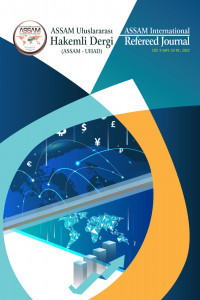THE TEACHINGS OF ISLAM AND THE EXAGGERATION OF PHOBIA: ANSWER TO THE ISLAMOPHOBIC AND RECOVERING THE MUSLIM IDENTITY
The main objective of this article a discussion on behalf of Islam worldwide known word ‘Islamophobia’, a Western term and thought and a disputed issue for the Muslim world. Particularly in the aftermath of 9/11, Muslims are often stereotypically portrayed in media reports as a devoutly religious and undifferentiated group sharing a fundamentalist version of Islam. So, in this article it will discuss with some major offshoots and basically depended on the qualitative method from the previous research analysis and recently collected data. Especially on Europe’s ignorance in the medieval period about the Islam and Muhammad, as they imagined that our worship to Christ and their worship to Muhammad are same and although they have known to Muhammad as an anti-Christ. The explanation against the Islam and reverse meaning of the Quran’s verses from its basic meaning in the Western world are common. After 9/11, why new-Muslim numbers are increasing in the Western world as like as in America, United Kingdom, and in others? Finally, some answers to the Islamophobics according to the Islam as Islam does not react with the illegal activities by the name of war.
Anahtar Kelimeler:
İslamofobi, Müslümanlar, Muhammed, İslam Öğretileri, Batı
The Teachings of Islam and the exaggeration of phobia: Answer to the Islamophobic and Recovering the Muslim Identity
The main objective of this article a discussion on behalf of Islam worldwide known word ‘Islamophobia’, a Western term and thought and also a disputed issue for the Muslim world. Particularly in the aftermath of 9/11, Muslims are often stereo typically portrayed in media reports as a devoutly religious and undifferentiated group sharing a fundamentalist version of Islam. So, in this article it will discuss with some major offshoots and basically depended on the qualitative method from the previous research analysis and recently collected data. Especially on Europe’s ignorance in the medieval period about the Islam and Muhammad, as they imagined that our worship to Christ and their worship to Muhammad are same and although they have known to Muhammad as an anti-Christ. The explanation against the Islam and reverse meaning of the Quran’s verses from its basic meaning in the Western world are common. After 9/11, why new-Muslim numbers are increasing in the Western world as like as in America, United Kingdom, and in others? Finally, some answers to the Islamophobic according to the Islam as Islam does not react with the illegal activities by the name of war.
Keywords:
Islamophobia, Muslims, Muhammad, Teachings of Islam, Western,
___
- Ahmed, A. Shahid, (2017), “Islamophobia Thriving In Europe, New Report Says” https://www.huffingtonpost.com/entry/islamophobia-thriving-in-europe-new-report-says_us_58dd909ce4b05eae031e8eb4, (Date of Access: 09.12.2017)
- Akkoc, R. (2015), “Mapped: What the world's religious landscape will look like in 2050” http://www.telegraph.co.uk/news/worldnews/11518702/Mapped-What-the-worlds-religious-landscape-will-look-like-in-2050.html, (Date of Access: 08.12.2017)
- Aktaş, M. (2014), “Avrupa’da Yükselen İslamofobi ve Medeniyetler Çatışması Tezi.” Ankara Avrupa Çalışmaları Dergisi, 13(1): 31-54.
- Barlas, A. (2000). “Jihad, Holy War, and Terrorism: The Politics of Conflation and Denial.” The American Journal of Islamic Social Sciences, 20(1): 46-62.
- Ciftci, S. (2012). “Islamophobia and Threat Perceptions: Explaining Anti-Muslim Sentiment in the West.” Journal of Muslim Minority Affairs 32(3): 293–309.
- Erbaş, A. (1998). “Müslüman-Hıristiyan Münasebetleri Sürecinde Hıristiyanlann İslam'a ve Müslümanlara Bakışı.” ILAM Araştırma Dergisi, 3(1): 117-153.
- Fuad, A. R. (2015). “The Teachings of Islam for the Prevention of Terrorism.” Monthly Perspective Magazine, 12(8): 30-36.
- Gardner, R., Karakaşoğlu, Y., Luchtanberg, S. (2008). “Islamophobia in the Media: a response from multicultural education.” Intercultural Education, 19 (2): 119-136.
- Hoyland, R. G. (2000). “The earliest christian writings on Muhammad: an appraisal” In H. Motzki (Ed.), The Biography of Muhammad Brill. pp. 277-286.
- Kalin, I. (2007). İslam ve Batı, Istanbul: İsam Yayınları
- Korkut, S. (2008). “Batı Düşüncesinde İslam ve Hz. Muhammed İmajı.” M.Ü. ilahiyat Fakültesi Dergisi, 34(1): 5-54.
- Latif, A., Munir, H.S. (2014). “Terrorism and Jihad, An Islamic Perspective” Journal of Islamic Studies and Culture, 2(1): 69-80.
- Mc Cambridge, J. B. (2016). Dante And Islam: A Study of The Eastern Influences in The Divine Comedy, Master’s Thesis, Indiana University, India.
- Meyendorff, J. (1964). “Byzantine Views of Islam.” Dumbarton Oaks Papers, Vol-18, pp. 113-132.
- PEW RESEARCH CENTER, (2017), “U.S. Muslims Concerned About Their Place in Society, but Continue to Believe in the American Dream”, http://www.pewforum.org/2017/07/26/findings-from-pew-research-centers-2017-survey-of-us-muslims/#muslims-concerned-about-extremism-both-globally-and-in-u-s, (Date of Access: 07.12. 2017)
- Safi, L. M. (1988). “War and Peace in Islam.” The American Journal of Social Science, 5(1): 29-57.
- Sheridan, L.P. (2006). “Islamophobia Pre– and Post–September 11th, 2001.” Journal of inter personal Violance, 21(3): 317-336.
- ISSN: 2148-5879
- Yayın Aralığı: Yılda 2 Sayı
- Başlangıç: 2014
- Yayıncı: Adaleti Savunanlar Stratejik Araştırmalar Merkezi Derneği
Sayıdaki Diğer Makaleler
SELÇUKLU DEVLETİNDE TASAVVUFİ UNSURLARIN YÖNETİM ÜZERİNDEKİ ETKİLERİ
1951 MÜLTECİ SÖZLEŞMESİ VE İNSAN HAKLARI HUKUKUNDA GERİ GÖNDERMEME İLKESİ
CUMHURİYET DÖNEMİNDE HAKKARİ'DE EĞİTİM (1923-1960)
TÜRKİYE’DE YÖNETİM FONKSİYONLARI AÇISINDAN ÖZEL GÜVENLİK HİZMETLERİNİN ÖRGÜTLENMESİ
